Mites bites: signs, effects and prevention
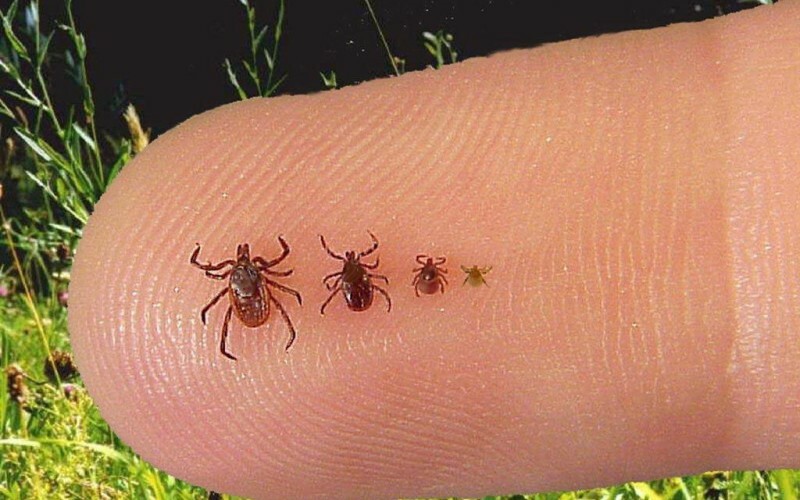
The spring-summer period is the ideal time for a pleasant pastime in nature, and for ticks is the best time to attack a person.Meet with these arthropods can be in the park, in the woods and even in the suburban area.In addition to the unpleasant spectacle, which is a tick sucked to the body, such a meeting can lead to infection with severe infectious diseases, among which tick-borne encephalitis, Lyme disease and others.
Table of contents: Features of dangerous mites for humans Where do ticks live?The first signs of a tick bite What should I do if the tick is bitten?Recommendations for removing ticks The consequences of a tick bite How to protect yourself from tick bites?Features of dangerous for human ticks
In nature, there are more than 40,000 species of ticks. Among them, blood-sucking ixodid mites are the most dangerous for humans. They resemble small brown bugs with four pairs of legs and proboscis( the size of a hungry individual is about 5 mm, a full-grown mite usually increases several times).
During the bite, along with the tick's saliva, the pathogen of infectious diseases enters the human body. 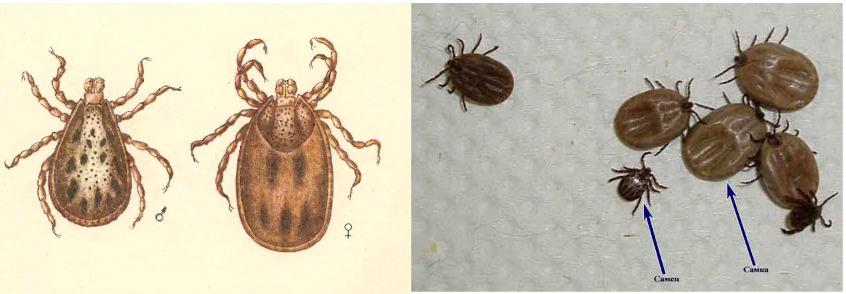
However, not all mites are generally carriers of infections.Many of them are sterile, that is, they do not contain viruses and bacteria dangerous for humans( the number of contagious and non-contagious ticks varies depending on the region).But since it is impossible to determine whether it is infected or not according to the appearance of the tick, it is always necessary to remain vigilant always.
Bite people, both females, and males of arthropods.Usually this happens after the end of a long autumn and winter hibernation - the mites wake up and need blood.The source of nutrition for them can be both an animal and a person.
There is a hunt for potential food as follows: the mite, with the help of hooks on the legs, climbs on the blades of grass or sticks upward and waits for the victim, if any, the arthropod is grabbing it with its forelegs and begins to look for a place suitable for bite.Those people who think that a mite can fall on the head from a tree are mistaken, these animals over a lifetime overcome no more than 10 m distance and do not climb the trees exactly.On the neck and on the head they can be found only because they, after hitting the human body, always move upward in search of an open and "juicy" skin area.
Where do ticks live?
Favorite habitats of ixodid ticks in nature are wet and shaded areas:
- ravines;
- the bottom of the meadows;
- forest edges;
- are overgrown with willow-grass on the shore of forest reservoirs;
- curbs of forest trails.
First signs of a tick bite
As a rule, people do not feel the very moment of the bite, but find a tick when it already firmly sucked to the body. This is explained simply: during the piercing of the victim's skin, the arthropod, along with saliva, secretes into the wound active substances that have some analgesic effect.
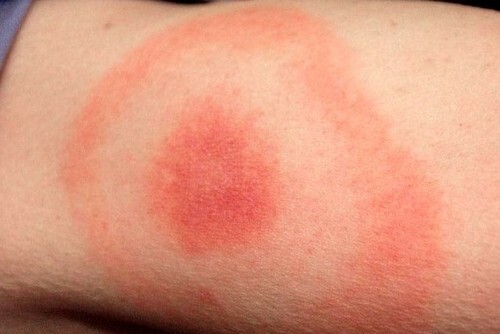 In people susceptible to allergies, a pronounced allergic reaction with pruritus and redness of the skin can develop at the site of the bite. In rare cases, a tick bite can lead to Quinck's swelling and anaphylactic shock.Symptoms of these conditions are as follows: puffiness of the face, shortness of breath, sudden deterioration of well-being, loss of consciousness, etc.In addition, due to a tick bite, a person's body temperature can rise, there is an ache in the muscles and joints, chills, severe drowsiness.
In people susceptible to allergies, a pronounced allergic reaction with pruritus and redness of the skin can develop at the site of the bite. In rare cases, a tick bite can lead to Quinck's swelling and anaphylactic shock.Symptoms of these conditions are as follows: puffiness of the face, shortness of breath, sudden deterioration of well-being, loss of consciousness, etc.In addition, due to a tick bite, a person's body temperature can rise, there is an ache in the muscles and joints, chills, severe drowsiness.
In general, the severity of the body's reaction to a bite of arthropods depends on the state of health.In allergic people, young children, the elderly, the reaction can be very violent.In healthy adults, contact with the tick can not affect the well-being in any way, and they learn about the fact of the bite only when they see an incomprehensible education on their body.
What should I do if I bite a tick?
As the probability of infection with dangerous infections increases significantly with prolonged contact of the human body with a tick, the main thing that needs to be done is to remove the arthropod. But to carry out the procedure of removal should be done correctly, so as not to crush and damage the tick, because this can further contribute to infection.In addition, the tick can and even needs to be inspected in the laboratory for the fact of infectiousness, and for this it must remain intact.
Therefore, if there are no skills for removing ticks, but there is a possibility, it is better to contact the nearest medical institution, where they will conduct a qualified extraction of the arthropod and will give recommendations on further actions. In addition, to ask all the questions of interest regarding tactics of behavior in the presence of a tick on the body, you can call 103( by calling an ambulance).
Recommendations for the removal of ticks
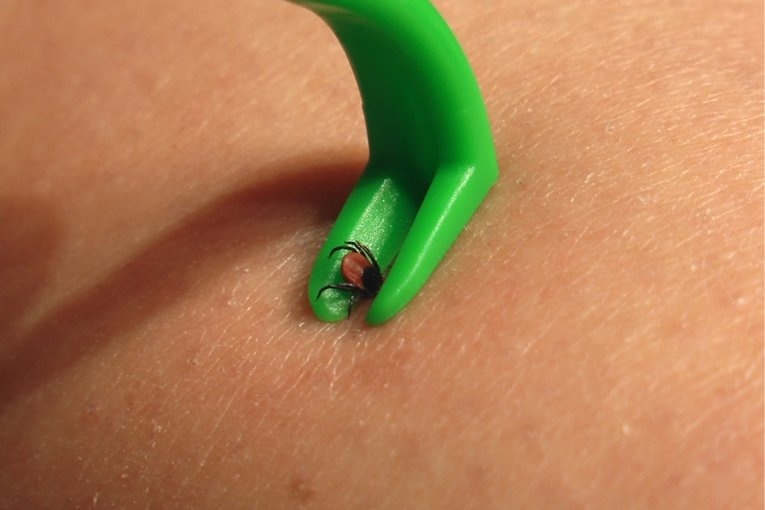
The tick is best removed by a special device that is sold in pharmacies.This can be a "lasso handle," UNICKLIN TIC TWISTER, etc. If there are no pharmacies nearby, you can use ordinary cosmetic tweezers or a sewing thread.
The person who removes the tick must take care of their safety - put on rubber gloves or wrap their fingers around with a bandage. It is also advisable to prepare in advance a plastic container with a lid or a plastic bag for the tick( so that it can be safely delivered to the laboratory).
The removal procedure itself should be performed as follows:
- Grasp the arthropod with a forceps or special device as close to the proboscis( this part of the animal's body is in the skin).If a thread is used, it is necessary to make a loop from it, which must be carefully tightened over the tick head inserted into the skin.
- Smoothly pull up.In this case, one should not make great efforts, from them the mite can simply burst, and all its contents will fall on the skin and into the wound.In addition, the proboscis of a arthropod at a sharp snatch remains in the wound, because of this, inflammation and even suppuration may occur.
- After removing the mite, wash skin with soap and water and treat with any means containing alcohol.There is no need to apply a bandage.If the head of the arthropod is left in the skin, you should try to remove it from the body with a sterile needle as a splinter.
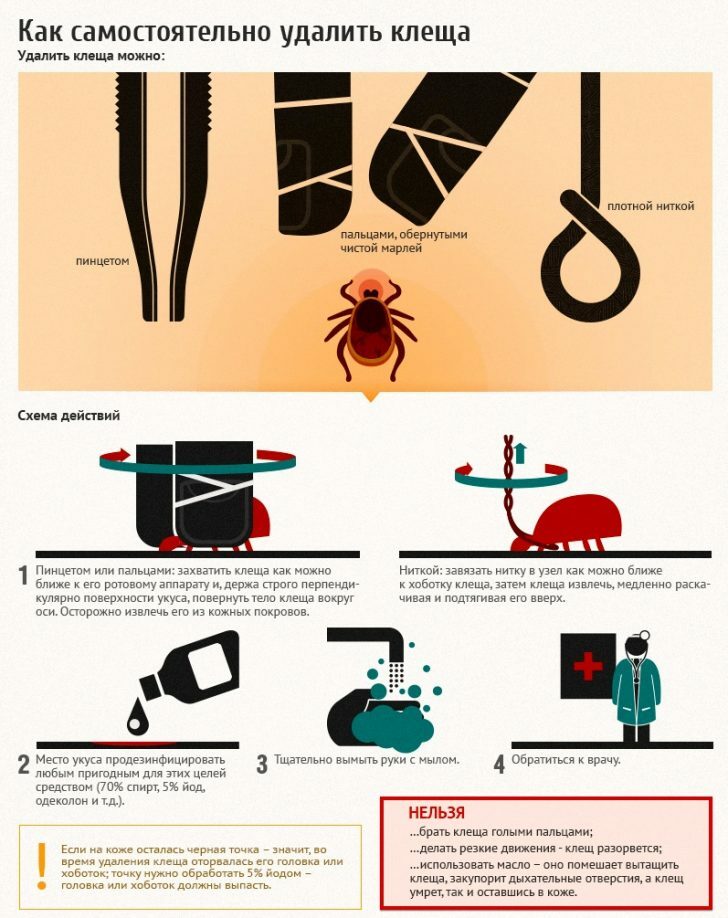 Important: sunflower oil, greasy ointments, airtight dressings and other folk remedies for mites are not effective, their use only takes precious time.
Important: sunflower oil, greasy ointments, airtight dressings and other folk remedies for mites are not effective, their use only takes precious time.
After removing the mite, it is advisable to do the following:
- Mark the date on the calendar when everything happened.
- Call your GP or family doctor, explain the situation and ask about the need and timing of blood tests and some preventive measures( in some cases, to prevent the development of tick-borne encephalitis, the bitten ticks are injected with immunoglobulins, antiviral drugs, etc..).
- Take the mite to the laboratory.Information about laboratories can be found on the website of the Federal Service for Consumer Rights Protection of the Russian Federation.
It is necessary to visit a physician in the following cases:
- If signs of inflammation( swelling, redness, etc.) occur in the bite area.
- If in the interval from 3 to 30 days after the bite, red spots appeared on the skin.
- If the body temperature has increased, there was muscle pain, unmotivated weakness and other unpleasant symptoms( these signs are especially important to monitor during the first 2 months after the bite).
Consequences of a tick bite
Ixodes ticks are carriers of the following infectious diseases:
- Tick-borne encephalitis, in which a patient due to damage to the gray matter of the brain, there are various neurological disorders, mental disorders, even a lethal outcome is possible.
- Tick-borne borreliosis( Lyme disease) is a polymorphic disease in which the skin, lymphatic system, joints, heart and other internal organs are affected.Borrelia, pathogens of borreliosis, are most often found in the study of ixodid ticks.
- Monocyte erlichiosis, which is characterized by neurologic disorders, general toxication syndrome, inflammation of the respiratory tract and other pathological manifestations.
- Granulocyte anaplasmosis.This disease resembles ARI or intestinal infection and proceeds fairly easily.In persons with weakened immunity, it is possible to develop complications from the nervous system and kidneys.
How to protect yourself from tick bites?
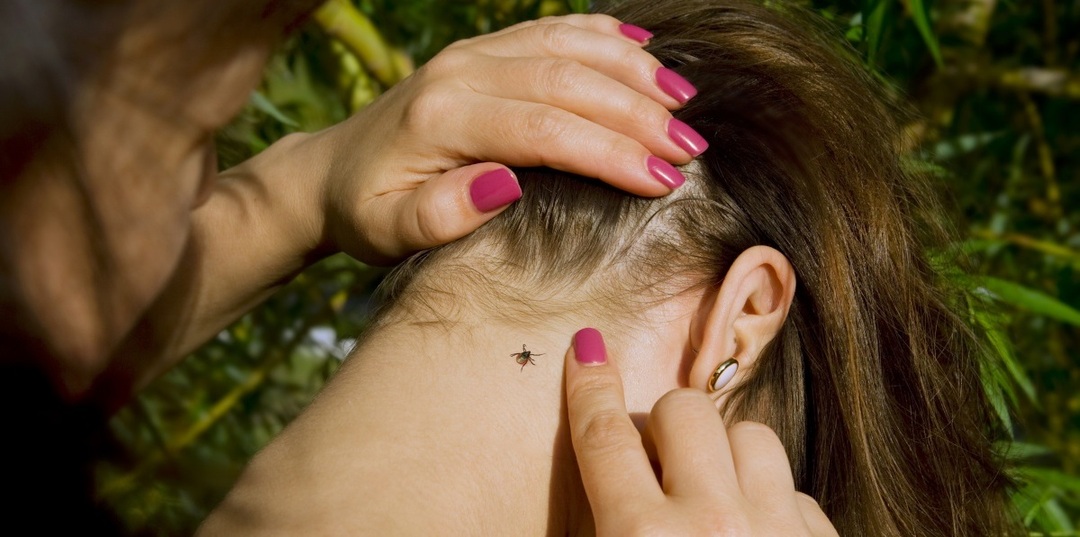 To avoid becoming a victim of ticks, a number of rules must be followed when visiting potentially hazardous places( park, forest, etc.):
To avoid becoming a victim of ticks, a number of rules must be followed when visiting potentially hazardous places( park, forest, etc.):
- Wear proper clothing.It should be light, so that the mites are visible, and the maximum covering and protecting the body from falling arthropods by the collar, under the leg, under the sleeve.Since the mites attack from below, pants should always be filled in socks and boots.
- Always use repellent.To date, manufacturers offer a large amount of protective equipment against ticks, among them you can choose safe even for young children.Also there are special suits impregnated with acaricidal substances.When contact with acaricides, mites die and fall away from clothing.
- Move along the widest possible paths, minimizing the contact of feet with grass and bushes.
- Periodically inspect clothing.
- After returning home, it is important to examine both clothes and body, paying special attention to the following places: ears, hairline, interdigital folds, popliteal areas, inguinal region, perineum, navel.
In regions with a high incidence of tick-borne encephalitis, residents are advised to be vaccinated.To date, this is the best way to protect against a dangerous disease.
Zubkova Olga Sergeevna, medical reviewer, epidemiologist-doctor



